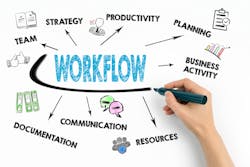Eliminate Hidden Costs by Focusing on Material Workflows
By Ed Williams
A profitable construction project is a result of a successful blend of material, labor, and equipment management. Self-performing general contractors and subcontractors can no longer afford to rely on traditional ways of working.
Many contractors are switching to construction-specific software that is eliminating the hidden costs while at the same time increasing productivity.
When building an ecosystem of all things construction it’s important to make the process of remodeling certain spaces cost-effective and transparent. But construction projects come with a number of hidden costs of material utilization. What contractors need to do is avoid incurring these hidden costs that often originate due to numerous factors on both the contractors’ and the clients’ end.
Let us examine what are some of the hidden material costs and how to eliminate them by focusing on material workflows.
Pre-existing Conditions
There could be hidden costs due to any number of pre-existing conditions such as layers of earlier finishes that were not visible until construction had begun, the HVAC system simply not working, or some unresolved electrical wiring problem.
For a remodeler, it could mean discovering pipes or a structural column when the tearing down process begins. This will result in extra costs for redesign or removal in many cases.
To eliminate this difficulty builders must factor in contingency plans and take this into account while scheduling and planning.
Invoice Processing
Relying on manual processes to carry out billings and other tasks can result in mistakes. This may result in spending unnecessary time correcting and re-filing data. With this, the problem of back-and-forth communication between field and back-office also arises.
A lack of categorized cost codes and disjointed sets of data can make it tough to carry out analysis and makes retrieving information difficult. The result of this disorganization is a cascading series of problems without any one single person held accountable.
The way to eliminate this problem is to automate processes by relying on construction enterprise resource planning (ERP) solutions that offer robust accounting features. Such solutions can help create cost templates and collect all project data in one place to carry out financial risk analysis.
Inventory Visibility
Maintaining accurate inventory is essential for a profitable construction business. Tracking financial information to maintain a file of billing may lead to error-prone entries. Manual, paper-based processes lead to broken purchasing and this may result in profit leaks if materials management is not rigorous.
This can be addressed by automating tasks and relying on a construction-specific solution to maintain inventory. It will also help contractors to get meaningful insights on material breakdown.
Ad Hoc Orders
There is always a concern related to lack of available data and limited time. Thus, an inability to track materials effectively and managing orders that is most often fixed on an ad hoc basis. This can be time-consuming and inefficient. Apart from wasting many valuable hours, it also impacts jobsite operations. The result is delays, mistakes, and higher material costs.
To keep the entire project team aligned you must pay attention to planning and scheduling. The right digital solutions can help with integrating data, and with robust reporting capabilities you can track project progress. This can help contractors deal with unforeseen situations such as when the cost of PVC pipe spikes because of supply chain difficulties.
Incorrect Taxes and Billing Mistakes
The incorrect calculation of taxes that vary from state to state can add unexpected increases to materials prices. Billing mistakes, if not caught in time and accounted for, can compound the problem. Both these issues need to be dealt with at the earliest by either outsourcing this task (at a nominal fee) or investing in construction solutions that have powerful accounting tools to address the problem.
Way Forward
HVAC and plumbing applications are driving growth in the construction industry. Technology is allowing contractors to consider energy efficient options when handling residential and commercial installations.
The emergence of voice-control devices in the home is driving the demand for newer HVAC systems. On the plumbing side, consumers are demanding smarter solutions that can deliver greater water efficiency and greater personalization of the bathroom and kitchen experience.
To avoid mistakes and inefficiencies contractors need to embrace digital systems that help in troubleshooting problems. Late deliveries, repetitive data entry, and delayed payments can be easily prevented with the help of dedicated tools that facilitate communication. By upgrading their offering contractors can rely on smart fixtures and appliances to diagnose problems and send alerts for maintenance.
Other than that, purpose-built construction software allows information to flow accurately. By gaining visibility on accounting systems and processes that connect disjointed workflows, contractors will be better equipped to deal with hidden costs of material utilization. So get ready to mitigate materials utilization problems and become a top-performing contractor.
Ed Williams is the Senior Team Lead at ProjectPro, an integrated construction accounting software. He holds a massive industry experience and is a Microsoft Dynamics expert who is focused on successful implementations. He is a visionary leader and always aim to deliver the best to the construction and project-oriented industries.
